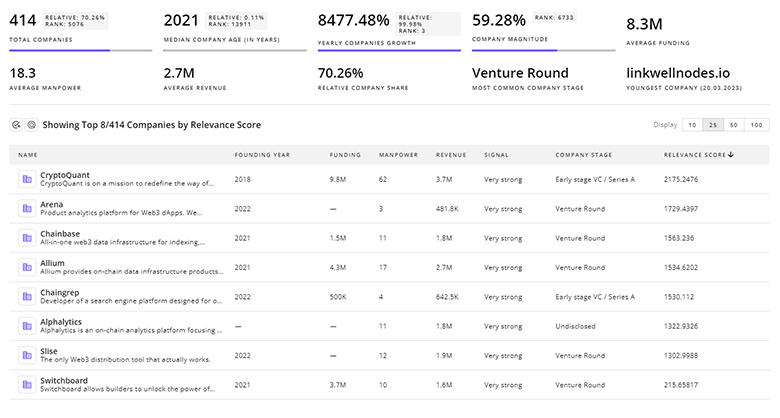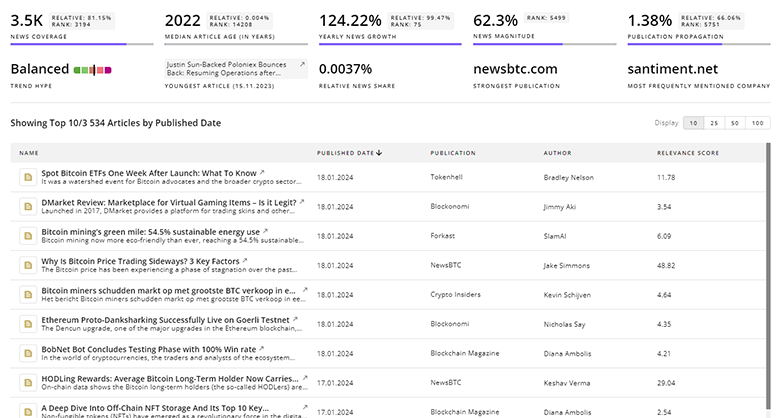
AI Health Assistant Report
: Analysis on the Market, Trends, and TechnologiesThe AI health assistant market is at a rapid inflection point: internal data value shows a 2024 market size of USD 1.40 billion and a projected CAGR of 54.2%, signaling very fast commercial expansion and adoption. External market studies and news confirm strong demand across provider, payer, and consumer channels—virtual nursing and home-care assistants lead near-term clinical deployments while investor flow and clinical pilots validate clinical utility and cost savings.
This report was last updated 15 days ago. Spot an error or missing detail? Help us fix it by getting in touch!
Topic Dominance Index of AI Health Assistant
To identify the Dominance Index of AI Health Assistant in the Trend and Technology ecosystem, we look at 3 different time series: the timeline of published articles, founded companies, and global search.
Key Activities and Applications
- Symptom triage and virtual triage workflows — real-time symptom assessment, risk stratification, and routing to appropriate care settings; deployments concentrate in telehealth and hospital front doors.
- Clinical decision support and early detection — assistants augment radiology, pathology, and specialist workflows by surfacing relevant findings and differential suggestions from multimodal data marketdataforecast.com.
- Clinical documentation and scribing automation — voice/NLP agents capture encounters and generate structured notes to reduce clinician administrative time and billing friction.
- Remote patient monitoring and chronic-care coaching — continuous vitals, medication reminders, and behavior nudges delivered via conversational interfaces and connected devices for chronic disease management.
- Administrative automation and patient navigation — appointment scheduling, billing assistance, and payer/member engagement workflows where virtual assistants reduce call center load and improve throughput.
Emergent Trends and Core Insights
- LLMs and conversational agents become operational tools, not just prototypes — companies are integrating safety-tuned LLMs for medical guidance and triage while emphasizing guardrails and specialized fine-tuning.
- Agentic, multi-modal assistants: systems that combine voice, text, EHR access, and device data to execute multi-step tasks (triage → order tests → schedule follow-up) reduce handoffs and decision latency Businesswire.
- Privacy-first architectures and federated learning gain traction — patents and product designs foreground on-device inference and model update sharing to meet HIPAA/GDPR constraints while preserving personalization.
- Measurable clinical and behavioral outcomes drive procurement — pilot data showing high diagnostic concordance and adherence improvements are converting trials into procurement discussions.
- Market segmentation is bifurcating: enterprise clinical assistants (hospital/payer integrations) versus consumer/home assistants (wellness, chronic care); each demands different regulatory and deployment models Databridgemarketresearch – Healthcare Virtual Assistants.
- Funding and commercialization dynamics: investors back platform plays with end-to-end ROI claims; funding surges in late 2023 validate investor appetite and support scale-up.
Technologies and Methodologies
- Large Language Models (LLMs) and fine-tuning for clinical safety — LLMs enable conversational triage, summarization, and question answering when constrained by medical safety layers and retrieval-augmented generation.
- Natural Language Processing and Clinical NLP — clinical note understanding, entity extraction, and automated coding underpin documentation and decision-support modules.
- Federated learning and on-device inference — privacy-preserving model updates and edge execution reduce regulatory friction and latency for sensitive workflows.
- Multimodal analytics — combining EHR, sensor/wearable streams, imaging, and voice to produce richer risk scores and actionable prompts Databridgemarketresearch – AI-driven Virtual Nursing Assistants.
- Explainable AI and human-in-the-loop workflows — XAI methods and clear escalation paths support clinician trust and regulatory submission requirements.
- Speech technologies and voice assistants (ASR/TTS) — voice interfaces dominate engagement in eldercare and home settings; TTS leads in usability metrics for elderly users.
AI Health Assistant Funding
A total of 118 AI Health Assistant companies have received funding.
Overall, AI Health Assistant companies have raised $1.3B.
Companies within the AI Health Assistant domain have secured capital from 374 funding rounds.
The chart shows the funding trendline of AI Health Assistant companies over the last 5 years
AI Health Assistant Companies
- Docus.ai — Docus.ai builds AI clinical-documentation agents that transcribe encounters and produce structured notes and coding suggestions. Its focus is on small to mid-sized practices where documentation burden directly affects throughput; the product integrates with common EHRs and targets measurable time savings per clinician.
- MeetAugust.ai — MeetAugust offers a conversational patient engagement assistant that automates intake, medication reminders, and care-plan adherence checks via chat and voice. The company positions its agent for post-discharge monitoring and shows early evidence of improving adherence and reducing readmission touchpoints.
- Yesil Health — Yesil Health focuses on virtual nursing and remote monitoring solutions for chronic disease, combining wearable data ingestion and conversational coaching. The company sells to payers and home-health providers, emphasizing reductions in unnecessary acute utilization through automated monitoring alerts.
- MiiHealth (MiiHealth.ai) — MiiHealth designs conversational companions for older adults that combine empathy-focused dialogue with medication reminders and care-team escalation. The product targets assisted-living operators and family caregivers where voice and simplicity drive adoption.
Identify and analyze 388 innovators and key players in AI Health Assistant more easily with this feature.

388 AI Health Assistant Companies
Discover AI Health Assistant Companies, their Funding, Manpower, Revenues, Stages, and much more
AI Health Assistant Investors
TrendFeedr’s investors tool offers a detailed view of investment activities that align with specific trends and technologies. This tool features comprehensive data on 384 AI Health Assistant investors, funding rounds, and investment trends, providing an overview of market dynamics.

384 AI Health Assistant Investors
Discover AI Health Assistant Investors, Funding Rounds, Invested Amounts, and Funding Growth
AI Health Assistant News
Stay informed and ahead of the curve with TrendFeedr’s News feature, which provides access to 139 AI Health Assistant articles. The tool is tailored for professionals seeking to understand the historical trajectory and current momentum of changing market trends.

139 AI Health Assistant News Articles
Discover Latest AI Health Assistant Articles, News Magnitude, Publication Propagation, Yearly Growth, and Strongest Publications
Executive Summary
AI health assistants now occupy a practical growth corridor where clinical benefit, operational return, and regulatory attention converge. Short-term commercial winners will be those that (1) prove measurable clinical or administrative ROI in real deployments, (2) embed privacy-first architectures that meet regional regulatory tests, and (3) integrate smoothly into existing EHR and telehealth workflows to avoid costly workflow change. Investors and provider buyers should prioritize verifiable outcome metrics (reduced documentation hours, improved adherence, triage accuracy) and prefer modular platforms that can be safety-tuned for specific clinical pathways. The next 24 months will decide which vendors scale as core clinical infrastructure and which remain niche point solutions; the data suggest the market will reward clinical evidence, integration depth, and privacy-centric technical designs.
Interested in enhancing our coverage of trends and tech? We value insights from experts like you - reach out!













